Posts Tagged ‘gutter deicing wire’
Thursday, December 22nd, 2016

Roof deicing cable
HeatTapePro is a premium brand of commercial-grade, self-regulating heat cable. We are strategic partners with the Radiant Solutions Company, the direct manufacture of HeatTapePro and all related installation accessories.
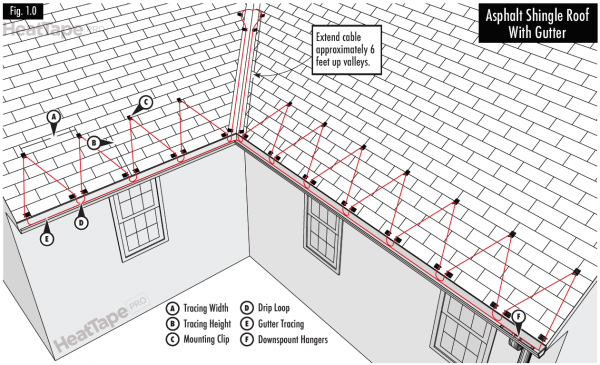
Ice dam roof deicing cable installation information
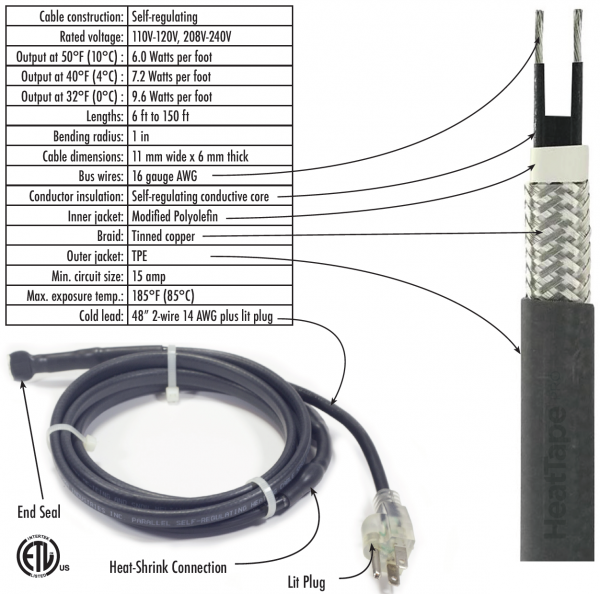
HeatTapePro self-regulating heat cable
HeatTapePro self-regulating heat cables are designed to be used for a variety of roof de-icing, gutter de-icing and pipe freeze applications. Self-regulating heat cable automatically calls for more energy when ambient outdoor temperatures are lower and conversely, less energy when outdoor temperatures are higher. HeatTapePro is pre-terminated in our factory for your safety and convenience. No field modifications will be necessary to the cable to use it for the described purposes.
You can purchase HeatTapePro through our store here or at The Heat Cable Store, , Ebay or Amazon.
Tags: best ice dam heat cable, best rated ice dam heat tape, gutter deicing wire, Heat cable, heat tape, heater cable, heater coils, highest quality heat cable, Ice dam heat tape, ice dam heat wires, minneapolis ice dam removal
Posted in ice dam coils, Ice dam heat cable, Ice Dam Heat Tape, Ice Dam Prevention, Ice Dam Removal, Ice Dam Removal with Steam | Comments Off on Heat Tape Pro Self-Regulating Heat Cable
Monday, December 5th, 2016
1. Water Damage
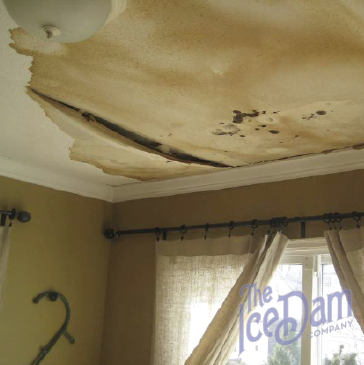
2. Ruined Insulation
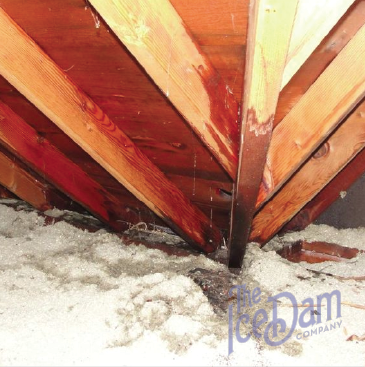
3. Mold and Mildew
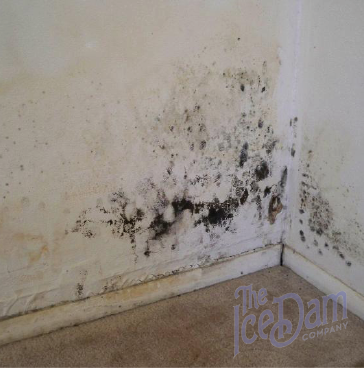
4. Gutter Damage
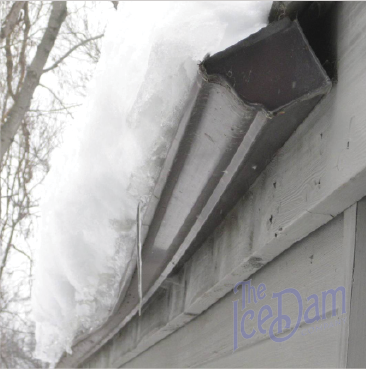
5. Property Damage
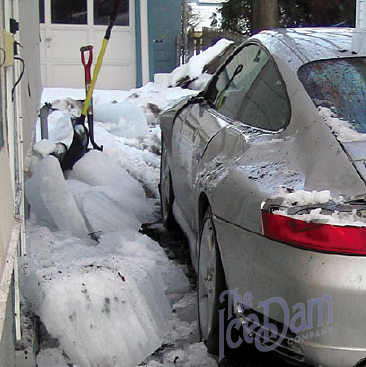
6. Soffit Damage
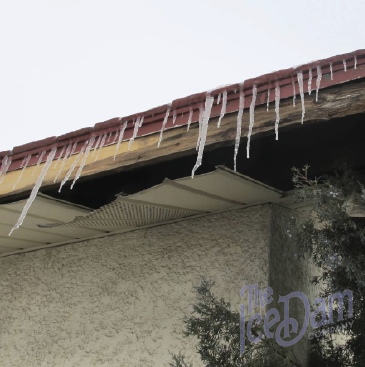
7. Landscaping Damage

8. Falling Ice
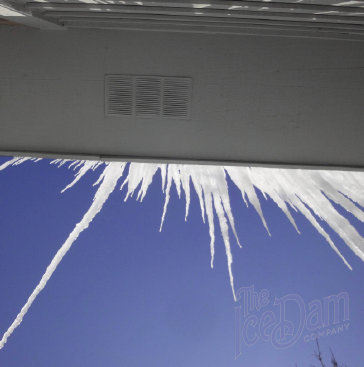
9. Flooring Damage
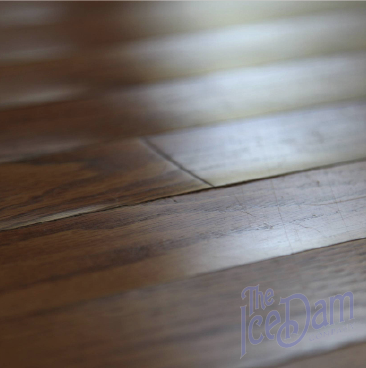
To read more Case Studies click here.
Tags: about ice dams, best ice dam removal in minneapolis, best rated ice dam removal contractor, commercial ice removal, edina ice dam removal, edina ice dam steaming, gutter deicing wire, highest rated ice dam removal company in minneapolis, how do I know I have ice dams, how to file an insurance claim for an ice dam, ice and snow removal, ice dam expert, ice dam removal jerks, minneapolis ice dam removal, orono ice dam removal, roof ice steaming, twin cities ice dam remover, wayzata ice dam removal
Posted in Ice Dam Prevention, Ice Dam Removal, Ice Dams, Misc., Ice Dams: General Info, Water Damage | Comments Off on 9 Common Types of Ice Dam Damage
Saturday, October 1st, 2016
There is a lot of misinformation out there on the topic of ice dams. Our goal here is to be the single definitive source for all things relating to ice dams. Towards that end, here are some common misconceptions about ice dams, roof snow, roof ice and gutter ice removal.
FACT: Ice dams can occur with virtually no snow on your roof. It’s a question of ice accumulations. It takes very little actual moisture to form ice dams. Even a dusting of snow can create a problem. Of course it is most often the case the thick snow accumulations create ice dams more quickly, but don’t be fooled into complacency because it’s a low snow season. See Case Study #09.
FICTION: Gutters have something to do with ice dams. The truth is gutters have nothing whatsoever to do with ice dams. See Case Study #03 for proof. If your home is prone to ice dams you will get them regardless of whether or not you have gutters. If you have gutters they will fill with ice and provide a foundation for the ice dam above. True. If you don’t have gutters, the ice dam simply builds on the cold edge of the roof. We provide ice dam removal for many homes each year that do not have gutters. In fact, some of our repeat clients have removed their gutters upon the advice of a dumb person only to be shocked that the ice dams came back the season after. Whoops.
FACT: Gutter systems can be damaged by ice. We see it every year. A section of otherwise fine gutter is either on the ground or hanging pathetically off the edge of the roof, filled with ice. Ice weighs about 60 pounds per cubic foot and gutters are not designed to tolerate that sort of load. It’s important to initiate gutter ice removal sooner than later for this reason. See Case Study #11 for common ice dam damage.
FICTION: When it comes to insulation, the more the better. Improperly insulated homes are just as bad as under insulated homes when it comes to ice dams. We have fixed countless bad insulation jobs for this reason. Specifically, we frequently find insulation done in such a way as to inhibit proper ventilation. Moreover, if you don’t address air leakage into the attic or rafter spaces, all the insulation in the world won’t prevent ice dams. See Case Study #04 for details about good eave ventilation.
FACT: You can’t always see ice dams from the ground. It’s true that you can often spot a monster ice dam quite quickly. It’s easy to spot the two foot icicles and the little adjoining glacier on your gutter. The sneaky ones are usually above skylights or in roof pan areas far out of sight. Sometimes ice dams grow up valleys and on top of dormers making it almost impossible to identify from the ground. See Case Study #02 for more information on where ice dams form on residential homes.
FICTION: Salt socks are a smart way to address ice dams. People use pantyhose, old socks and store-bought cloth tubes filled with a variety of ice-melting compounds for removing ice dams. Corrosive substances like rock salt, sodium chloride, calcium chloride, magnesium chloride and more to melt channels through their ice dams. Some compounds are better than others, but all present risks you should keep in mind. Some of the aforementioned chemicals affect the integrity or color of your roof, some are corrosive to the aluminum when gutter ice is removed this way, some are corrosive to valley metal and other flashings, some damage plant life as the water drains below. You are rolling the dice when you go this route so be aware. See Case Study #13 for more information on salt socks (salt in pantyhose).
FACT: Ice should be removed by steam. Here is the skinny. We are roofers and have fixed hundreds of roofs that have been damaged by well-intentioned professionals with hammers, picks and hatchets in their pursuit of removing ice dams to help their clients. The damage we have found caused by the less-than-professional souls is almost funny if it wasn’t so serious. In our years we have seen jobs with picks and hammers where removing ice dams was done successfully. It get’s down to the question of whether you want to take that risk? We strongly advise against the hack-a-teer approach even if it is a little cheaper. Roof Ice and Gutter Ice should always be removed with steam.
FICTION: Ice dams need to be thick to cause a problem. Ice dams as thin as one inch can cause big problems. A good general rule is that the steeper your roof, the thicker the ice dam has to be to cause problems. On lower pitched roofs even a thin ice dam can hurt.
FACT: The leaking caused by ice dams may not show up right away. It would be nice if water stains or mold manifested immediately upon entering your home but it simply does not work that way. Often the water that ice dams push into homes travels around wall and ceiling cavities, trapped by vapor barriers and other materials until it finds the path of least resistance to escape. By the time you see water inside, it’s usually been there for a while, which results in mold and mildew.
To read more Case Studies click here.
Tags: about ice dams, best ice dam removal in minneapolis, best rated ice dam removal contractor, commercial ice removal, edina ice dam removal, edina ice dam steaming, gutter deicing wire, highest rated ice dam removal company in minneapolis, how do I know I have ice dams, ice and snow removal, ice dam expert, ice removal professionals, minneapolis ice dam removal, twin cities ice dam remover
Posted in Ice Dam Prevention, Ice Dam Removal, Ice Dams, Misc., Ice Dams: General Info, Water Damage | Comments Off on 10 Ice Dam Facts: Ice Dam Myths Explored
Monday, October 5th, 2015
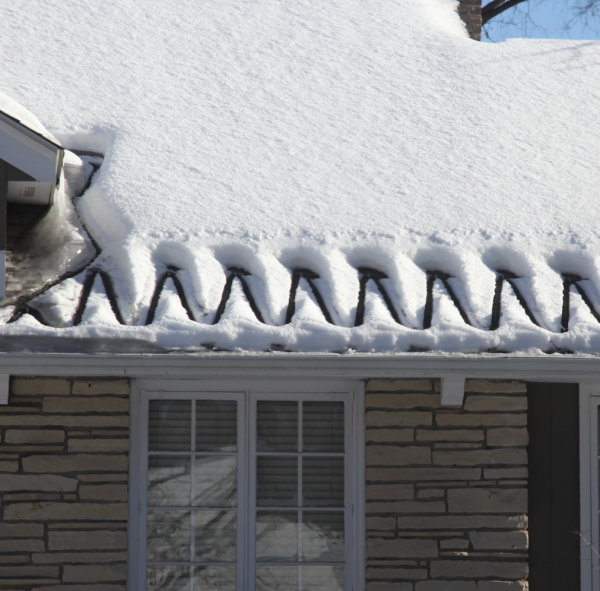
Roof deicing cable for ice dam prevention by the Ice Dam Company
Over the years we have heard people call heat cable many things.
Heat Coils for ice dam prevention:
Heat coils most likely get their name from the fact that the material itself, that is the heat cable, comes in coils and when installed by a hack is sometimes left in coils on the roof. Heat coils for ice dam prevention are of course the same thing as heat cables.
Roof deicing cables for ice dam prevention:
Roof deicing cables get their name from their primary purpose, to deice roofs. The name is a bit of a misnomer, however, because technically, roof deicing cables do not deice the entire roof, or even the majority of it. Ice dam deicing cables only melt channels through a small percentage of the ice dam to enable the passage of water through the ice dam so water is not able to back up behind the ice dam, into the roof material and into the home. Roof deicing cable is commonly used in the control of ice dams. Notice that there is a big distinction between preventing ice dams and controlling ice dams. Roof deicing wire and roof deicing cable is not meant to prevent ice dams so much as it is meant to control the affects of ice dams on roofs.
Gutter heat cables, Gutter heat tape and Gutter deicing cable:
Gutter heat tape also known as gutter heat wire, is used in the same fashion as heat cable, heat tape and roof deicing cable. It’s primary purpose is to melt ice, or more specifically, to prevent the original formation of ice in the gutter. As discussed in the here general section, gutters in fact have nothing to do with either the creation or severity of ice dams. This isn’t to say that using gutter heat tape or gutter heat wire is a bad idea. Having hundreds of pounds of ice form in your gutter system causes problems of its’ own, most notably that the gutters can be ripped off the house by the weight of the ice itself. Gutter heating coils is yet another variation of this category of names.
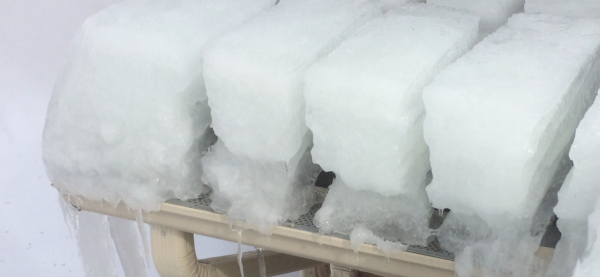
Gutter ice melting cable for ice dam prevention by The Ice Dam Company
Roof Heat Wire and Roof Heat Coils
As with other names, roof heat wire gets its’ name from the perception of its’ intended function. It’s just another way of saying heat cable or heat tape. Roof heat wire is wire on the roof that carries heat with the purpose of controlling ice dams or the damage created by ice formations on a roof.
Tags: gutter deicing wire, gutter heat coils, gutter heat wire, gutter heating cables, Heat cable, heat coils, heat tape for ice dams, heat wire for roof, heating coils for roof, ice dam heat cable, ice dam heat coil, Ice dam heat tape, ice dam prevention coils, ice dam prevention heat cable, roof deicing cable, roof deicing coils, roof deicing tape, roof deicing wire
Posted in Ice Dam Prevention, Ice Dams, Misc. | Comments Off on The Many Names of Ice Dam Heat Cable
Sunday, October 4th, 2015
HEAT CABLE CLIP COST:
CLICK HERE TO BUY ROOF CLIPS FOR SLATE ROOF HEAT CABLE INSTALLATION
$.78 to $1.22 Per Heat Cable Clip (Traditional, mechanically fastened clip used for standard asphalt roofs)
$25.00 to $35.00 Per Heat Cable Clip (Slotted clip used for slate, tile and cedar roofs)
$.78 to $1.22 Per Heat Cable Clip (Traditional, mechanically fastened clip)
We sell a wide variety of clips, brackets and doohickies for the installation of ice dam heat cable. There are three basic varieties of clips one can buy through the Ice Dam Company.
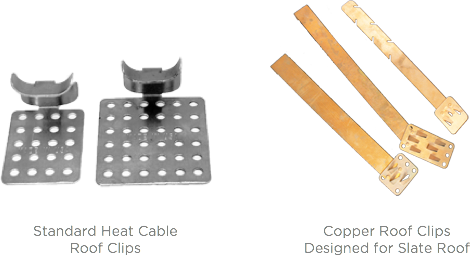
Roof clips for ice dam heat cables
Mechanically Fastened Heat Cable Clips:
This type of clip is either nailed or screwed onto the roof. It is by far the most common clip sold on The Ice Dam Company website and is used primarily to secure heat cables and roof deicing wire to asphalt roofs. Our installers use these clips to install ice dam heat cable by either nailing or screwing the clips directly to the roof surface, usually in conjunction with a blob of special polyurethane caulk. Once installed, these clips are used to hold the ice dam cable in place permanently without creating wear points that might eventually abrade through the cable and cause issues with functionality. The average cost of these heat cable and roof deicing wire clips for ice dam control is $.78 to $1.22 Per Heat Cable Clip, depending on style, color and order quantity.
Slotted Clips and Brackets for Heat Cable:
As the name suggests, this family of clips is slotted in order to allow installers to use existing fasteners on a roof system to hold the clip in place. The most common application is the slate roof clip or cedar roof clip. Such clips are slipped up, under the existing roofing material and hooked around the nails being used to hold the clip in place. Using slotted heat cable clips is the suggested method of installing heat cable and roof deicing cables on slate roofs and sometimes on cedar roofs because of the non-invasive, non-destructive nature of the install. Slotted roof heat cable and roof deicing clips are far more expensive for ice dam prevention installations than traditional heat cable clips. The average cost of these heat cable and roof deicing wire clips for ice dam control is $25.00 to $35.00 Per Heat Cable Clip, depending on style, color and order quantity. The vast majority of the slotted clips we sell are made of copper and are for use on slate roofs.
Glue-on clips for ice dam heat cable and roof deicing cable:
The third and final style of clips we sell are Glue-on clips. These clips are used on metal and single ply roofing systems, such are EPDM (rubber) and TPO membranes. Installing heat cable and roof deicing wire on metal roofs is not nearly as common as on other systems such as asphalt roofs and slate roofs. Metal roofs are simply less prone to ice dams, or more specifically, to damage caused by ice dams. Single ply systems, or roof membranes like TPO or rubber roofs, are even less likely to suffer from the ill consequences of ice dams. This explains why we sell less of this style of roof clip than any other. The average cost of these heat cable and roof deicing wire clips for ice dam control is $.92 to $4.55 Per Heat Cable Clip, depending on style, color and order quantity.
Tags: about ice dams, gutter deicing wire, gutter heat coils, gutter heating cables, heat cable clips, heat wire clips for slate, heating coils for roof, roof deicing coils, roof heat tape clips, slate roof clips for heat wire, slate roof ice dam cable
Posted in Ice Dam Prevention, Ice Dams, Misc. | Comments Off on Clips and Brackets for Heat Cable, Heat Tape and Deicing Coils




















